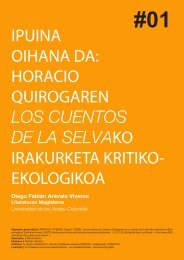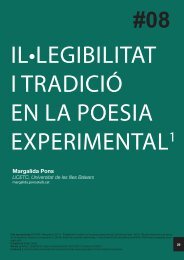03 - 452ºF
03 - 452ºF
03 - 452ºF
Create successful ePaper yourself
Turn your PDF publications into a flip-book with our unique Google optimized e-Paper software.
Je reste adossée à l’arbre sans oser le moindre mouvement. René me<br />
regarde et s’approche de moi. Puis il entoure le tronc de ses bras, je<br />
suis prisonnière. Son visage est si près que je retiens mon souffle. Lui<br />
respire encore très fort, à cause de la bataille. Il me serre contre le chêne<br />
et m’embrasse.<br />
I lean against the tree, not daring to stir. René looks at me and approaches<br />
me. Then he clasps the trunk with both his arms, I am a prisoner. His face<br />
is so close that I hold my breath. He is still breathing very hard, because<br />
of the battle. He squeezes me against the oak and kisses me. (1983:<br />
64-65)<br />
The illicit kiss marks a turning point in the novel after which the<br />
narrator’s relationship with her family completely devolves. She<br />
begins to deceive them, spending more time with René, Yves, and<br />
the children she meets in the marketplace: «Demain, je pars avec le<br />
cow-boy à la ferme de ses parents. J’ai dit aux miens que j’allais en<br />
pique-nique avec l’école et Rida m’a aidée à mentir» [Tomorrow, I’m<br />
leaving with the Cowboy to go to his parents’ farm. I told my parents<br />
that I’m going on a school picnic and Rida helped me deceive them]<br />
(1983: 65).<br />
We have established that René is our cowboy of twentiethcentury<br />
popular culture since Lachmet has essentially integrated<br />
the western—with all its inferences of mobility, competitiveness,<br />
and rugged individualism—into her text and onto the landscape<br />
of colonial Algeria. The western dramatizes and affirms masculine<br />
values by making the struggles of the heroic male protagonist on the<br />
frontier a narrative focus. While the cowboy symbolizes American<br />
values of individual male competition, aggression, and separation<br />
from community and family; the woman in the cowboy-western<br />
represents the values of the mythic past that centre on family, home<br />
and community (Cawelti, 2004: 87). In the context of colonial Algeria,<br />
on the cusp of war, this American mythology finds itself destabilized<br />
by the self-conscious love of two children—a cowboy and his daisy—<br />
performing Wild West gender roles. Lachmet thus asks us implicitly<br />
to approach the text as a possible site of resistance—where notions<br />
of authenticity are challenged. A discussion of intertextuality—an<br />
integral part of métissage as I read it—is apropos here.<br />
3. Intertextuality and Dialogism: Theorizing resistance/<br />
Theorizing métissage<br />
Distinguished by the praxis of writing with other authors, it is my<br />
understanding that intertextuality employs «a kind of language<br />
which, because of its embodiment of otherness, is against, beyond<br />
and resistant to (mono) logic. Such language is socially disruptive,<br />
revolutionary even» (Allen, 2000: 45). Ultimately a dialogic process,<br />
it weaves together texts, cultural references, and languages and has<br />
«Je suis un cowboy du Far West»: A study of textual métissage in Djanet Lachmet’s autobiographical novel Le Cow-boy (1983) - Caroline Kelley<br />
<strong>452ºF</strong>. #<strong>03</strong> (2010) 85-101.<br />
93










